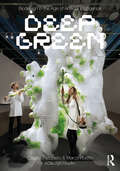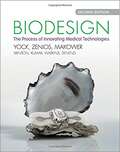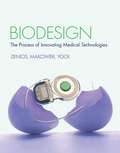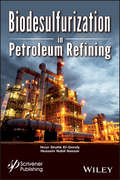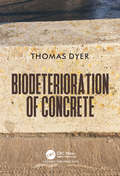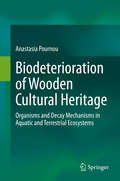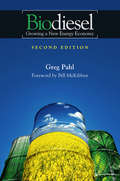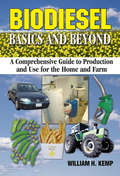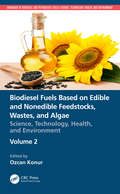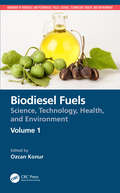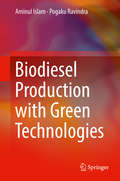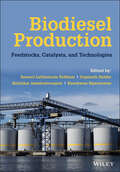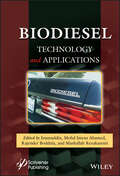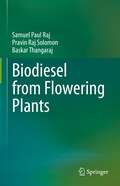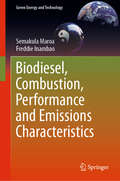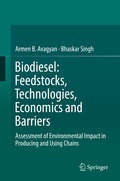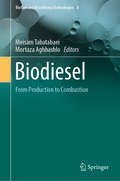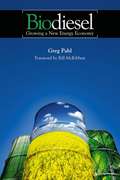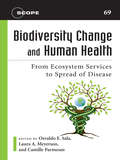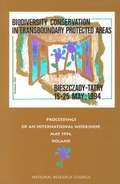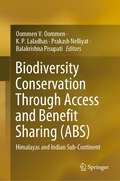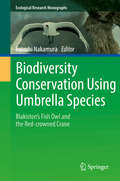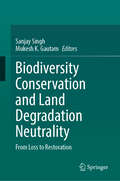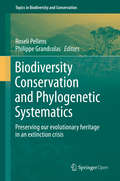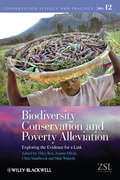- Table View
- List View
Biodesign in the Age of Artificial Intelligence: Deep Green
by Marco Poletto Claudia PasqueroBiodesign in the Age of Artificial Intelligence: Deep Green investigates the potential of nature-based technology for shaping the evolution of contemporary architecture and design. It takes on the now pervasive topic of design intelligence, extending its definition to encompass both biological and digital realms. As in their first title, Systemic Architecture: Operating Manual for the Self-Organizing City, the authors engage the topic through the specific lens of their innovative design practice, ecoLogicStudio, and their research at the University of Innsbruck and at the Bartlett, UCL. Part One of the book, entitled PhotoSynthetica™, illustrates design solutions that engage the urban microbiome and seek to achieve an immediate impact, while Part Two, entitled Deep Green, includes synthetic landscapes and operates within a much larger spatio-temporal frame, going beyond human perception and life span to envision design as a geographical and geological force. In the age of catastrophic climate change, such perceptual expansion helps to clarify that change cannot simply be stopped or rolled back. We must instead establish more positive dynamics of change within the living world. To this end, this book proposes to engage with design and architecture as an extended cognitive interface, a sentient being that is co-evolutionary and symbiotic with the living planet, contributing to its beauty and to our continued enjoyment of it.
Biodesign: The Process of Innovating Medical Technologies
by Uday N. Kumar Thomas M. Krummel Stefanos Zenios Josh Makower Lyn Denend Todd J. Brinton Paul G. Yock F. T. Jay Watkins Christine Q. KuriharaThis step-by-step guide to medical technology innovation, now in full color, has been rewritten to reflect recent trends of industry globalization and value-conscious healthcare. Written by a team of medical, engineering, and business experts, the authors provide a comprehensive resource that leads students, researchers, and entrepreneurs through a proven process for the identification, invention, and implementation of new solutions. Case studies on innovative products from around the world, successes and failures, practical advice, and end-of-chapter 'Getting Started' sections encourage readers to learn from real projects and apply important lessons to their own work. A wealth of additional material supports the book, including a collection of nearly one hundred videos created for the second edition, active links to external websites, supplementary appendices, and timely updates on the companion website at ebiodesign.org. Readers can access this material quickly, easily, and at the most relevant point in the text from within the ebook.
Biodesign: The Process of Innovating Medical Technologies
by Uday N. Kumar Thomas M. Krummel Paul Yock Stefanos Zenios Josh Makower Lyn Denend Todd J. BrintonRecognize market opportunities, master the design process, and develop business acumen with this 'how-to' guide to medical technology innovation. A three-step, proven approach to the biodesign innovation process - identify, invent, implement - provides a practical formula for innovation. The experiences of hundreds of innovators and companies, in the form of case studies, quotes and practical advice, offer a realistic, action-orientated roadmap for successful biodesign innovation. Real-world examples, end-of-chapter projects, and Getting Started sections guide the reader through each of the key stages of the process and provide a template to create their own new medical devices. Addressing common medical, engineering, and business challenges to develop well-rounded expertise, this book is the complete package for any biodesign entrepreneur. The text is supported by valuable resources, including up-to-date industry changes: found at ebiodesign.org.
Biodesulfurization in Petroleum Refining
by Nour Shafik El-Gendy Hussein Mohamed NassarPetroleum refining and process engineering is constantly changing. No new refineries are being built, but companies all over the world are still expanding or re-purposing huge percentages of their refineries every year, year after year. Rather than building entirely new plants, companies are spending billions of dollars in the research and development of new processes that can save time and money by being more efficient and environmentally safer. Biodesulfurization is one of those processes, and nowhere else it is covered more thoroughly or with more up-to-date research of the new advances than in this new volume from Wiley-Scrivener. <p><p> Crude oil consists of hydrocarbons, along with other minerals and trace elements. Sulfur is the most abundant element after carbon and hydrogen, then comes after it nitrogen, and they usually concentrated in the higher boiling fractions of the crude oil. The presence of sulfur compounds causes the corrosion of refining facilities and catalysts poisoning. Moreover, the presence of nitrogen-compounds directly impacts the refining processes via; poisoning the cracking catalysts and inhibiting the hydrodesulfurization catalysts. In addition, both have bad impacts on the environment, throughout the sulfur and nitrogen oxide emissions. Removing this sulfur and nitrogen from the refining process protects equipment and the environment and creates a more efficient and cost-effective process. <p> Besides the obvious benefits to biodesulfurization, there are new regulations in place within the industry with which companies will, over the next decade or longer, spend literally tens, if not hundreds, of billions of dollars to comply. Whether for the veteran engineer needing to update his or her library, the beginning engineer just learning about biodesulfurization, or even the student in a chemical engineering class, this outstanding new volume is a must-have. Especially it covers also the bioupgrading of crude oil and its fractions, biodenitrogenation technology and application of nanotechnology on both bio-desulfurization and denitrogenation technologies.
Biodeterioration of Concrete
by Thomas DyerAwareness of the importance of ensuring durability of concrete has been a growing concern of engineers, and there is now considerable understanding of the mechanisms, which cause its deterioration, and means of limiting such damage through the use of appropriate materials and approaches to design. Many of the deterioration mechanisms, which affect concrete, are the result of interaction with the non-living environment – chlorides in seawater, carbon dioxide in the atmosphere, cyclic freezing and thawing. However, living organisms can also cause damage – through both chemical and physical processes - which under the right conditions, can be severe. This book looks at all forms of concrete biodeterioration together for the first time. It examines, from a fundamental starting point, biodeterioration mechanisms, as well as the conditions which allow living organisms (bacteria, fungi, plants and a range of marine organisms) to colonise concrete. A detailed evaluation of chemical compounds produced by living organisms with respect to their interaction with the mineral constituents of concrete, and the implications it has for the integrity of structures, is also included. Approaches to avoiding biodeterioration of concrete are also covered, including selection of materials, mix proportioning, design, and use of protective systems.
Biodeterioration of Wooden Cultural Heritage: Organisms and Decay Mechanisms in Aquatic and Terrestrial Ecosystems
by Anastasia PournouSince prehistoric times and throughout the course of human evolution, wood has been an integral part of all civilizations. Wooden Cultural Heritage can be found worldwide, providing valuable information on the social and economic context of human history. Nonetheless, as a natural cellulosic material, wood shows low resistance to biodeterioration and thus wooden Cultural Heritage often fails to escape decomposition in both aquatic and terrestrial ecosystems. This book provides a comprehensive overview on the biodeterioration of wooden Cultural Heritage and describes the decay mechanisms of key organisms and microorganisms encountered in aquatic and terrestrial ecosystems. Cultural Heritage professionals, researchers and academics may explore within this book the associations between deteriogens, habitats and decay, which will assist them to understand wood biodeterioration and design effective prevention, mitigation and remediation strategies. The book presents case studies around the world to demonstrate the impact of biogenic deterioration on wooden Cultural Heritage and illustrates mechanisms and patterns in order to be a useful handbook of decay diagnosis.Lastly, by adopting a holistic approach to wood decay, basic concepts of wood technology, ecology, and deteriogens' biology are introduced, permitting readers of different scientific backgrounds to easily comprehend wood biodeterioration.
Biodiesel
by Greg PahlFor anyone who is trying to keep up with the extremely rapid developments in the biodiesel industry, the second edition of Biodiesel: Growing a New Energy Economy is an invaluable aid. The breathtaking speed with which biodiesel has gained acceptance in the marketplace in the past few years has been exceeded only by the proliferation of biodiesel production facilities around the United States-and the world-only to confront new social and environmental challenges and criticisms. The international survey of the biodiesel industry has been expanded from 40 to more than 80 countries, reflecting the spectacular growth of the industry around the world. This section also tracks the dramatic shifts in the fortunes of the industry that have taken place in some of these nations. The detailed chapters that cover the industry in the United States have also been substantially rewritten to keep abreast of its many new developments and explosive domestic growth. An expanded section on small-scale, local biodiesel production has been added to better represent this small but growing part of the industry. Another new section has been added to more fully explore the increasingly controversial issues of deforestation and food versus fuel, as well as GMO crops. The second edition concludes with updated views on where the industry is headed in the years to come from some of its key players.
Biodiesel Basics and Beyond
by William H. KempBiodiesel Basics and Beyond aims to separate fact from fiction and to educate potential home, farm, and cooperative manufacturers on the economic production of quality biodiesel from both waste and virgin oil feedstock. The book includes: detailed processes and equipment required to produce biodiesel fuel that meets North American standards how farmers can use excess oilseed as a feedstock for biodiesel production the use of the co-byproduct glycerin in the making of soap a guide to numerous reference materials and a list of supplier data This is North America's definitive guide to responsibly producing biodiesel from waste vegetable oil while minimizing your environmental footprint in the process.
Biodiesel Fuels Based on Edible and Nonedible Feedstocks, Wastes, and Algae: Science, Technology, Health, and Environment (Handbook of Biodiesel and Petrodiesel Fuels)
by Ozcan KonurThis second volume of the Handbook of Biodiesel and Petrodiesel Fuels presents a representative sample of the population papers in the field of feedstock-specific biodiesel fuels. The research on feedstocks for biodiesel fuels has first focused on the edible oils as first-generation biodiesel fuels. However, the public concerns about the competition with foods based on these feedstocks and adverse impact on the ecological diversity and deforestation have resulted in the exploration of nonedible-oil-based biodiesel fuels as second-generation biodiesel fuels in the first instance. Due to the ecological and cost benefits of treating wastes, waste oil-based biodiesel fuels as third-generation biodiesel fuels have emerged. Furthermore, following a series of influential review papers, the research has focused on the algal oil-based biodiesel fuels in recent years. Since the cost of feedstocks in general constitutes 85% of the total biodiesel production costs, the research focused more on improving biomass and lipid productivity in these research fields. Furthermore, since water, CO2, and nutrients (primarily N and P) have been major ingredients for the algal biomass and lipid production, the research has also intensified in the use of wastewaters and flue gases for algal biomass production to reduce the ecological burdens and the production costs. Part 1 presents a representative sample of the population papers in the field of edible oil-based biodiesel fuels covering major research fronts. It covers soybean oil-based biodiesel fuels, palm oil-based biodiesel fuels, and rapeseed oil-based biodiesel fuels as case studies besides an overview paper. Part 2 presents a representative sample of the population papers in the field of nonedible oil-based biodiesel fuels covering major research fronts. It covers Jatropha oil-based biodiesel fuels, polanga oil-based biodiesel fuels, and moringa oil-based biodiesel fuels as case studies besides an overview paper. Part 3 presents a representative sample of the population papers in the field of waste oil-based biodiesel fuels covering major research fronts. It covers wastewater sludge-based biodiesel fuels, waste cooking oil-based biodiesel fuels, and microbial oil-based biodiesel fuels as case studies besides an overview paper. Part 4 presents a representative sample of the population papers in the field of algal oil-based biodiesel fuels covering major research fronts. It covers algal biomass production in general, algal biomass production in wastewaters, algal lipid production, hydrothermal liquefaction of algal biomass, algal lipid extraction, and algal biodiesel production besides an overview paper. This book will be useful to academics and professionals in the fields of Energy Fuels, Chemical Engineering, Physical Chemistry, Biotechnology and Applied Microbiology, Environmental Sciences, and Thermodynamics. Ozcan Konur is both a materials scientist and social scientist by training. He has published around 200 journal papers, book chapters, and conference papers. He has focused on the bioenergy and biofuels in recent years. In 2018, he edited ‘Bioenergy and Biofuels’, that brought together the work of over 30 experts in their respective field. He also edited ‘Handbook of Algal Science, Technology, and Medicine’ with a strong section on the algal biofuels in 2020.
Biodiesel Fuels: Science, Technology, Health, and Environment (Handbook of Biodiesel and Petrodiesel Fuels)
by Ozcan KonurThis first volume of the Handbook of Biodiesel and Petrodiesel Fuels presents a representative sample of the population papers in the field of biodiesel fuels in general. Part I provides an overview of the research field on both biodiesel and petrodiesel fuels highlighting primary and secondary research fronts in these fields. Part II presents a representative sample of the population papers in the field of biooils covering major research fronts. The research on the biooils is a fundamental part of the research on the biodiesel fuels. The research in this field has intensified in recent years with the application of advanced catalytic technologies and nanotechnologies in both production and upgrading of biooils. It covers pyrolysis, hydrothermal liquefaction, and upgrading, and characterization and properties of biooils besides an overview of the research field. Part III presents a representative sample of the population papers in the field of biodiesel fuels in general covering major research fronts. The research in this field has progressed in the lines of production, properties, and emissions of biodiesel fuels. As in the case of biooils, catalysts and additives play a crucial role for the biodiesel fuels. It covers biomass-based catalyst-assisted biodiesel production, enzymatic biodiesel production, additives in biodiesel production, properties, characterization, performance, and policies of biodiesel fuels besides an overview of the research field. Part IV presents a representative sample of the population papers in the field of glycerol, biodiesel waste, covering major research fronts. The research in this field has intensified in recent years with the increasing volume of biodiesel fuels, creating eco-friendly solutions for these wastes of biodiesel fuels for producing valuable biofuels and biochemicals from glycerol. It covers biohydrogen and propanediol production from glycerol as a case study for bioenergy and biochemicals, respectively. This book will be useful to academics and professionals in the fields of Energy Fuels, Chemical Engineering, Physical Chemistry, Biotechnology and Applied Microbiology, Environmental Sciences, and Thermodynamics. Ozcan Konur is both a materials scientist and social scientist by training. He has published around 200 journal papers, book chapters, and conference papers. He has focused on the bioenergy and biofuels in recent years. In 2018, he edited Bioenergy and Biofuels, which brought together the work of over 30 experts in their respective field. He also edited the Handbook of Algal Science, Technology, and Medicine with a strong section on the algal biofuels in 2020.
Biodiesel Production with Green Technologies
by Pogaku Ravindra Aminul IslamThis book provides a single-source reference to green technologies in advanced biofuel technology. The main focus is on the description of the state of the art in catalytic processes for the "green" production of biofuels. The authors describe two different, practical approaches for catalysts, which allow for effective and easy separation of the catalyst by simple filtration, and enable reuse for several cycles. Readers will gain understanding as to the mechanisms involved in the synthesis and structure formation of the catalyst, in order to maximize yield of biodiesel production. The authors also address the question of how catalytic material should be distributed inside a porous support to obtain optimal performance. The effects of physicochemical and operating parameters are analyzed to gain insight into the underlying phenomena governing the performance of optimally designed catalysts.
Biodiesel Production: Feedstocks, Catalysts, and Technologies
by Samuel Lalthazuala Rokhum Gopinath Halder Suttichai Assabumrungrat Kanokwan NgaosuwanAn incisive discussion of biofuel production from an economically informed technical perspective that addresses sustainability and commercialization together In Biodiesel Production: Feedstocks, Catalysts and Technologies, renowned chemists Drs Rokhum, Halder, Ngaosuwan and Assabumrungrat present an up-to-date account of the most recent developments, challenges, and trends in biodiesel production. The book addresses select feedstocks, including edible and non-edible oils, waste cooking oil, microalgae, and animal fats, and highlights their advantages and disadvantages from a variety of perspectives. It also discusses several catalysts used in each of their methods of preparation, as well as their synthesis, reactivity, recycling techniques, and stability. The contributions explore recently developed technologies for sustainable production of biodiesel and provides robust treatments of their sustainability, commercialization, and their prospects for future biodiesel production. A thorough introduction to the various catalysts used in the preparation of biodiesel and their characteristics Comprehensive explorations of biofuel production from technical and economic perspectives, with complete treatments of their sustainability and commercialization Practical discussions of the development of new strategies for sustainable and economically viable biodiesel production In-depth examinations of biodiesel feedstocks, catalysts, and technologiesPerfect for academic researchers and industrial scientists working in fields that involve biofuels, bioenergy, catalysis, and materials science, Biodiesel Production: Feedstocks, Catalysts and Technologies will also earn a place in the libraries of bioenergy regulators.
Biodiesel Technology and Applications
by Inamuddin Mohd Imran Ahamed Rajender Boddula Mashallah RezakazemiEnergy technologies have attracted great attention due to the fast development of sustainable energy. Biodiesel technologies have been identified as the sustainable route through which overdependence on fossil fuels can be reduced. Biodiesel has played a key role in handling the growing challenge of a global climate change policy. Biodiesel is defined as the monoalkyl esters of vegetable oils or animal fats. Biodiesel is a cost-effective, renewable, and sustainable fuel that can be made from vegetable oils and animal fats. Compared to petroleum-based diesel, biodiesel would offer a non-toxicity, biodegradability, improved air quality and positive impact on the environment, energy security, safe-to-handle, store and transport and so on. Biodiesels have been used as a replacement of petroleum diesel in transport vehicles, heavy-duty trucks, locomotives, heat oils, hydrogen production, electricity generators, agriculture, mining, construction, and forestry equipment. This book describes a comprehensive overview, covering a broad range of topics on biodiesel technologies and allied applications. Chapters cover history, properties, resources, fabrication methods, parameters, formulations, reactors, catalysis, transformations, analysis, in situ spectroscopies, key issues and applications of biodiesel technology. It also includes biodiesel methods, extraction strategies, biowaste utilization, oleochemical resources, non-edible feedstocks, heterogeneous catalysts, patents, and case-studies. Progress, challenges, future directions, and state-of-the-art biodiesel commercial technologies are discussed in detail. This book is an invaluable resource guide for professionals, faculty, students, chemical engineers, biotechnologists, and environmentalists in these research and development areas.
Biodiesel from Flowering Plants
by Samuel Paul Raj Pravin Raj Solomon Baskar ThangarajThis book offers an exhaustive coverage of process modifications in biodiesel production from oil drawn from 84 oleaginous plant species occurring in all parts of the world, thereby enlisting the scope and potential of many new and non-conventionally obscure plant sources. Biodiesel, now prepared from major vegetable oils, has become a compulsion to offset the dwindling reserve of petro-diesel, which naturally intrudes into the cooking oil demand. This has necessitated search for new sources. The book consolidates the biodiesel production from oils being extracted from conventional plants and also from a plethora of new and non-conventional plants along with their habit and habitats, history of biodiesel’s invention, explanation on species-wise biodiesel process variables, catalytic inclusions, global standards, fuel properties varying with species, blending benefits, cost effectiveness, shelf life, ignition characteristics, fuel consumption and engine performances with eco-friendly exhaust. This book is of immense use to teachers, researchers, scientists of climatology and carbon footprint, energy consultants, fuel chemists, students of agriculture and forestry, automobile engineering, industrial chemistry, environmental sciences and policy makers or anyone who wishes to scale up the biodiesel industry.
Biodiesel, Combustion, Performance and Emissions Characteristics (Green Energy and Technology)
by Semakula Maroa Freddie InambaoThis book focuses on biodiesel combustion, including biodiesel performance, emissions and control. It brings together a range of international research in combustion studies in order to offer a comprehensive resource for researchers, students and academics alike. The book begins with an introduction to biodiesel combustion, followed by a discussion of NOx formation routes. It then addresses biodiesel production processes and oil feedstocks in detail, discusses the physiochemical properties of biodiesel, and explores the benefits and drawbacks of these properties. Factors influencing the formation of emissions, including NOx emissions, are also dealt with thoroughly. Lastly, the book discusses the mechanisms of pollution and different approaches used to reduce pollutants in connection with biodiesel. Each approach is considered in detail, and diagrams are provided to illustrate the points in line with industry standard control mechanisms.
Biodiesel: Assessment of Environmental Impact in Producing and Using Chains
by Bhaskar Singh Armen B. AvagyanAir pollution policy is closely connected with climate change, public health, energy, transport, trade, and agriculture, and generally speaking, the Earth has been pushed to the brink and the damage is becoming increasingly obvious. The transport sector remains a foremost source of air pollutants – a fact that has stimulated the production of biofuels. This book focuses on the biodiesel industry, and proposes a modification of the entire manufacturing chain that would pave the way for further improvements. Oil derived from oilseed plantations/crops is the most commonly used feedstock for the production of biodiesel. At the same time, the UK’s Royal Academy of Engineering and 178 scientists in the Netherlands have determined that some biofuels, such as diesel produced from food crops, have led to more emissions than those produced by fossil fuels. Accordingly, this book re-evaluates the full cycle of biodiesel production in order to help find optimal solutions. It confirms that the production and use of fertilizers for the cultivation of crop feedstocks generate considerably more GHG emissions compared to the mitigation achieved by using biodiesel. To address this fertilization challenge, projecting future biofuel development requires a scenario in which producers shift to an organic agriculture approach that includes the use of microalgae. Among advanced biofuels, algae’s advantages as a feedstock include the highest conversion of solar energy, and the ability to absorb CO2 and pollutants; as such, it is the better choice for future fuels. With regard to the question of why algae’s benefits have not been capitalized on for biofuel production, our analyses indicate that the sole main barrier to realizing algae’s biofuel potential is ineffective international and governmental policies, which create difficulties in reconciling the goals of economic development and environmental protection.
Biodiesel: From Production to Combustion (Biofuel and Biorefinery Technologies #8)
by Meisam Tabatabaei Mortaza AghbashloThis book presents in-depth information on the state of the art of global biodiesel production and investigates its impact on climate change. Subsequently, it comprehensively discusses biodiesel production in terms of production systems (reactor technologies) as well as biodiesel purification and upgrading technologies. Moreover, the book reviews essential parameters in biodiesel production systems as well as major principles of operation, process control, and trouble-shooting in these systems. Conventional and emerging applications of biodiesel by-products with a view to further economize biodiesel production are also scrutinized. Separate chapters are dedicated to economic risk analysis and critical comparison of biodiesel production systems as well as techno-economical aspects of biodiesel plants. The book also thoroughly investigates the important aspects of biodiesel production and combustion by taking advantage of advanced sustainability analysis tools including life cycle assessment (LCA) and exergy techniques. In closing, the application of Omics technologies in biodiesel production is presented and discussed. This book is relevant to anyone with an interest in renewable, more sustainable fuel and energy solutions.
Biodiesel: Growing a New Energy Economy
by Greg PahlThe potential of biodiesel to replace petroleum-based diesel (petrodiesel) fuel is not new. Farmers and alternative fuels advocates have been experimenting with and using vegetable oils to operate tractors, trucks, generators and all sorts of other engines for decades. In Europe, Pahl reports, biodiesel has been manufactured on an industrial scale since 1992 and with strong government support from the European Union it has replaced 2 percent of the petrodiesel use in member countries. The goal there is to increase that percentage to 5.75 by 2010 in order to reduce dependence on foreign oil and to cut back on greenhouse emissions.
Biodiversity Change and Human Health: From Ecosystem Services to Spread of Disease (SCOPE Series #69)
by Osvaldo E. Sala Camille Parmesan Laura A. MeyersonBiodiversity Change and Human Health brings together leading experts from the natural science and social science realms as well as the medical community to explore the explicit linkages between human-driven alterations of biodiversity and documented impacts of those changes on human health. The book utilizes multidisciplinary approaches to explore and address the complex interplay between natural biodiversity and human health and well-being. The five parts examine health trade-offs between competing uses of biodiversity (highlighting synergistic situations in which conservation of natural biodiversity actually promotes human health and well-being); relationships between biodiversity and quality of life that have developed over ecological and evolutionary time; the effects of changing biodiversity on provisioning of ecosystem services, and how they have affected human health; the role of biodiversity in the spread of infectious disease; native biodiversity as a resource for traditional and modern medicine Biodiversity Change and Human Health synthesizes our current understanding and identifies major gaps in knowledge as it places all aspects of biodiversity and health interactions within a common framework. Contributors explore potential points of crossover among disciplines (both in ways of thinking and of specific methodologies) that could ultimately expand opportunities for humans to both live sustainably and enjoy a desirable quality of life.
Biodiversity Conservation In Transboundary Protected Areas: Proceedings of an International Workshop Bieszczady and Tatra National Parks, Poland May 15-25, 1994
by National Research Council Staff Alicja Breymeyer Reginald NobleRecognizing the increasing rate of species loss on a global scale and that neither pollution nor ecosystems respects political boundaries, cooperation on many different levels is required to conserve biodiversity. This volume uses four protected areas that Poland shares with its neighbors as case studies to explore opportunities to integrate science and management in transboundary protected areas in Central Europe for the conservation of biodiversity. Specific topics include biodiversity conservation theories and strategies, problems of wildlife management, and impacts of tourism and recreational use on protected areas.
Biodiversity Conservation Through Access and Benefit Sharing (ABS): Himalayas and Indian Sub-Continent
by K. P. Laladhas Oommen V. Oommen Prakash Nelliyat Balakrishna PisupatiThis book deals with the economic potentials of biodiversity and its capacity to support its own conservation aiming to provide livelihood for millions engaged in conservation, both now and for future generations. The book highlights the potentials of natural resources which are characterized as capital wealth (as defined in Convention on Biological Diversity (CBD)), to finance its own conservation and to provide livelihood means to people who conserve it.The book is divided into five Parts. PART I explains about the Premise of Access and Benefit Sharing (ABS), PART II describes about the Technology Transfer, PART III will provide details about the Access to Genetic Resources and to Associated Traditional Knowledge and Benefit Sharing PART IV is the Implementation of ABS Mechanisms and PART V is about ABS and Its Economics.This book will be of interest to biodiversity policy makers, administrators, university and college students, researchers, biodiversity conservationists.
Biodiversity Conservation Using Umbrella Species: Blakiston's Fish Owl And The Red-crowned Crane (Ecological Research Monographs)
by Futoshi NakamuraThis book focuses on Blakiston’s fish owl and the red-crowned crane as umbrella species. Healthy river, riparian and wetland ecosystems are necessary to maintain the populations of the two species. Both species have been revered by people since ancient times, but both are currently listed as endangered because of their small population sizes. The population decline of the two species can be mainly attributed to the degradation of the natural riparian and wetland habitats, which is associated with land use development.The populations of the two species are now recovering in Japan due to recent conservation and reproduction efforts, but the genetic diversity of the two species are still low due to previous bottleneck effects. To develop conservation and dispersal plans to establish the species over the East Asian mainland and on the island of Hokkaido, basic information, such as their regional distribution, genetic diversity, food availability, reproductive traits, and nesting, breeding, rearing, and commuting habitat, is essential. The intensive, collaborative studies conducted in Japan and Russia has clarified the status quo and the ecology of the two species. This is the first book that comprehensively compiles the above information for the mainland and island populations. In addition, it verifies their suitability as umbrella species of an ecosystem and the possibility of their future population expansion, taking into account changes in land use in Hokkaido, which is about to experience a dramatic decline in human population. As such, the book provides valuable information for students who wish to learn about these beautiful symbolic creatures, for NGOs engaged in conservation activities, and for managers who are involved in creating conservation plans and implementing restoration projects.
Biodiversity Conservation and Land Degradation Neutrality: From Loss to Restoration
by Sanjay Singh Mukesh K. GautamThis book highlights various issues related to biodiversity conservation and land degradation, and the global challenges faced in achieving land degradation neutrality. It then discusses the importance of ecosystem restoration as a pivotal strategy in solving these issues. Ecosystem diversity and its health directly influence land productivity and its range of ecosystem services. Achieving land degradation neutrality is crucial for restoring and reinforcing biodiversity's structure and function, which ultimately plays vital role in building climate resilience. To substantiate these ideas, this book presents practical case studies and exemplifies best practices in plant, animal and ecosystem conservation. It prominently highlights the intricate interplay of complex drivers behind land use, land use change, and land degradation. It also examines the direct consequences of land degradation on biodiversity and explore global efforts, frameworks, and strategies crucial for achieving land degradation neutrality. Furthermore, it integrates indigenous knowledge, policy framework and community engagement as instrumental components for achieving global targets related to sustainable land management. This book accentuates the significance of terrestrial ecosystems in achieving biodiversity goals outlined in SDG 15, Life on Land, through a multidisciplinary approach and contributions from academicians, policymakers, United Nations Organizations, and subject matter specialists. Thus, it is a resource for students, trainees, and researchers, providing them with knowledge and insights about significance of land degradation, land degradation neutrality, and biodiversity conservation.
Biodiversity Conservation and Phylogenetic Systematics: Preserving our evolutionary heritage in an extinction crisis (Topics in Biodiversity and Conservation #14)
by Roseli Pellens Philippe GrandcolasThis book is about phylogenetic diversity as an approach to reduce biodiversity losses in this period of mass extinction. Chapters in the first section deal with questions such as the way we value phylogenetic diversity among other criteria for biodiversity conservation; the choice of measures; the loss of phylogenetic diversity with extinction; the importance of organisms that are deeply branched in the tree of life, and the role of relict species. The second section is composed by contributions exploring methodological aspects, such as how to deal with abundance, sampling effort, or conflicting trees in analysis of phylogenetic diversity. The last section is devoted to applications, showing how phylogenetic diversity can be integrated in systematic conservation planning, in EDGE and HEDGE evaluations. This wide coverage makes the book a reference for academics, policy makers and stakeholders dealing with biodiversity conservation.
Biodiversity Conservation and Poverty Alleviation: Exploring the Evidence for a Link (Conservation Science and Practice)
by Matt Walpole Dilys Roe Chris Sandbrook Joanna ElliottBiodiversity conservation and poverty alleviation are both important societal goals demanding increasing international attention. While they may seem to be unrelated, the international policy frameworks that guide action to address them make an explicit assumption that conserving biodiversity will help to tackle global poverty. Part of the Conservation Science and Practice Series published with the Zoological Society of London, this book explores the validity of that assumption. The book addresses a number of critical questions: Which aspects of biodiversity are of value to the poor? Does the relationship between biodiversity and poverty differ according to particular ecological conditions? How do different conservation interventions vary in their poverty impacts? How do distributional and institutional issues affect the poverty impacts of interventions? How do broader issues such as climate change and the global economic system affect the biodiversity – poverty relationship at different scales? This volume will be of interest to policy-makers, practitioners and researchers concerned with understanding the potential - and limitations - of integrated approaches to biodiversity conservation and poverty alleviation.
